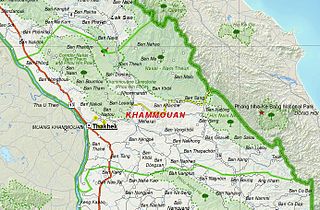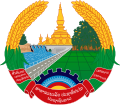Related Research Articles

Dams and reservoirs in Laos are the cornerstone of the Lao government's goal of becoming the "battery of Asia".
A National Biodiversity Conservation Area (NBCA) is an environmentally protected area in Laos. There are all together 21 different NBCAs in Laos, protecting 29,775 square kilometers. Another 10 NBCAs have been proposed, many of them being treated by authorities as though they were already officially protected.
The Nam Theun 2 Hydropower Project, or simply NT2, is a hydroelectric dam on the Nam Theun River in Laos. Commercial operation of the plant began in April 2010. The scheme diverts water from the Nam Theun, a tributary of the Mekong River, to the Xe Bang Fai River, enabling a generation capacity of 1,075 MW, from a 350 m (1,148 ft) difference in elevation between the reservoir and the power station.

Nam Ngum is a 354 km long river in Laos. It is a major tributary of the Mekong River.

The Nam Ou is one of the most important rivers of Laos. It runs 448 km from Phongsaly Province to Luang Prabang Province. The river rises in Muang Ou Nua, near the Lao-Chinese border and traverses the northern Laos mountains and gorges until meeting the Mekong River in Ban Pak Ou. Along with the Mekong, the Nam Ou is the only natural channel suitable for large-draft boat transportation. The Nam Ou is one of the 12 principal tributaries of the Mekong River. The river has a total area of nearly 26,000 km2. Near its confluence with the Mekong are the Pak Ou Caves, famous for their Buddha statues. The river is also surrounded by limestone karts, forests, and valleys. The river supports Lao rice cultivation. The Nam Ou placed in the top 80th percentile for river health according to the Mekong River Commission’s aquatic health index.
Hin Namno National Park is in Boualapha District, Khammouane Province, Laos. The park borders Phong Nha-Kẻ Bàng National Park of Vietnam to the east and Nakai-Nam Theun National Park of Laos to the north. Hin Namno National Park was created by prime ministerial decree in January 2020. It is managed by the Ministry of Agriculture and Forestry (MAF).
Nakai-Nam Theun National Park in Nakai District, Khammouane Province, Laos, is one of the last remaining wildernesses in Southeast Asia. Nakai-Nam Theun covers approximately 4,270 km2 of the Annamite Range and the adjacent Nakai Plateau in Khammouane and Bolikhamsai Provinces. It was designated a national park on 15 February 2019 by Prime Ministerial Decree No. 36, 15 February 2019. It is managed by the Ministry of Agriculture and Forestry (MAF). It is adjacent to the Vu Quang National Park of Vietnam.
Systomus jacobusboehlkei is a species of cyprinid fish native to the lower Mekong and Chao Phraya Basins of Cambodia, Vietnam, Laos, and Thailand. It inhabits marshlands and floodplains, swamps, and small, slow-flowing tributaries. It is present in local food fisheries, along with other small species. This species can reach a length of 12 centimetres (4.7 in) SL.

The Xe Bang Fai River is a river in Laos. It originates in the Annamite Range on the border between Laos and Vietnam at 17°3′1″N106°20′54″E. It flows through Khammouane Province and Savannakhet Province.
Tai Yo, also known as Tai Mène and Nyaw, is a Tai language of Southeast Asia. It is closely related to Tai Pao of Vietnam, where it may have originated. It was once written in a unique script, the Tai Yo script, but that is no longer in use. The language is known regionally in Laos and Thailand as Tai Mène and Tai Nyaw and, in Vietnam as Tai Do and Tai Quy Chau. Superficially, Tai Yo appears to be a Southwestern Tai language but this is only because of centuries of language contact and it is properly classified with the Northern Tai languages. The Nyaw/Nyo spoken in central Thailand and western Cambodia is not the same as Tai Yo.
The Houay Ho is a dam located in the Samakkhixay District of Attapeu Province, Laos, 160 km (99 mi) east of Pakse and 30 km (19 mi) northwest of Attapeu. The project is considered the first privately financed joint venture 'build-operate-transfer' (BOT) hydropower project in Laos. It has installed capacity of 152.1 megawatts (204,000 hp), almost all of which is exported to Thailand.

Attapeu is a province of Laos in the southeast of the country. It has five districts: Samakkixay, Xaysetha, Sanamxay, Sanxay, and Phouvong, covering an area of 10,320 square kilometres (3,980 sq mi) with a population of 127,285. Its capital city lies at Attapeu.

Bokèo is a northern province of Laos. It is the smallest and least populous province in the country. Bokeo province covers an area of 6,196 square kilometres (2,392 sq mi). Bokeo province borders Luang Namtha province to the northeast, Oudomxai province to the east, Xaignabouli province to the south, and Thailand to the southwest and Burma to the west and northwest. The province has five districts:. It is rich in deposits of precious and semiprecious stones. Bokeo's provincial capital is Houayxay on the Mekong River. The province is in the Golden Triangle, at the border of Myanmar and Thailand. There are 34 ethnic groups in the province. Houay Xay is the border town with Thailand and regional economic centre.

Bolikhamsai is a province of Laos. Pakxan, Thaphabat, Pakkading, Borikhane, Viengthong, and Khamkeut are its districts and Pakxan is its capital city. The province is the site of the Nam Theun 2 Dam, the country's largest hydroelectric project.

Khammouane province (Khammouan) is a province in the center of Laos. Its capital lies at Thakhek.

Xépôn, is a village in the Seponh District of Savannakhet Province, Laos. It was approximately 0.65 kilometres (0.40 mi) east of the intersection of the Sepon River and the Banghiang River. It was the target of Operation Lam Son 719 in 1971, an attempt by the armed forces of South Vietnam and the United States to cut the Ho Chi Minh Trail. The village now known as Old Xépôn was destroyed. In the 1990s, gold mining began at the site, helping to create Lao's largest private industry. Expansion of mining in the area has dislocated indigenous villages around Old Xépôn.
Scaphiodonichthys acanthopterus is a freshwater fish of the family Cyprinidae. It is found in clear, fast-moving streams and tributaries of the Mekong, Nam Xam, Da and Chao Phraya river basins in Indochina. S. acanthopterus is most commonly found in waterways with a rocky bottom and under complete tree cover.

Protected areas in Laos include:
Schistura colossa is a species of stone loach in the genus Schistura which has been recorded from the Xe Pian, Xe Set and Houay Champi rivers on the Bolaven Plateau in southern Laos. It was described by the Belgian ichthyologist Maurice Kottelat in 2017 and does not feature in Fishbase yet. The specific name colossa means giant, this species is one of the largest species of southeast Asian stone loaches.

The Nam Ou cascade hydropower project is a series of seven hydroelectric dams along the Nam Ou river which are located in the provinces of Phongsaly and Luang Prabang in northern Laos. The project is managed by the Power Construction Corporation of China (PowerChina) and the Lao government. The project is the series of dams include seven levels of reservoirs in an attempt to mitigate ecological deterioration. The construction of the hydropower project is being completed in two phases. Phase I of the dams, including Nam Ou 2, Nam Ou 5, and Nam Ou 6 began operating on May 12, 2016. Phase II of the dams, including Nam Ou 1, 3, 4, and 7 is expected to be completed in 2020.
References
- ↑ State of water environmental issues. Laos PDR. Accessed 01/04/2018.
- Rand McNally, The New International Atlas, 1993.
